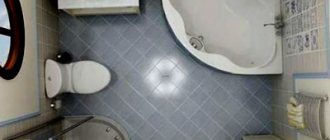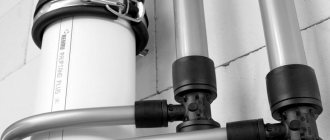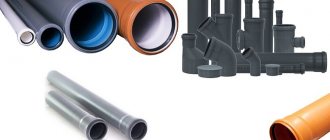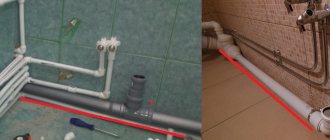General rules
Any change in the position of utility networks in the apartment is a redevelopment. If a sewerage system is being transferred, all actions must be roughly divided into 2 stages:
- approval of redevelopment, obtaining permission to carry out work;
- execution of the technical part.
The relocation of sewerage in the apartment must be approved by the BTI and other authorities. Without going into details, we note the complexity of this procedure. First, you need to do a survey of the premises and consult with specialists. It is necessary to find out to what extent the proposed changes are possible and acceptable.
Secondly, you will need a detailed plan for upcoming changes. It needs to be approved, then the work will have to be coordinated with the architecture department, etc. Officials or responsible persons are reluctant to accommodate apartment owners who want to make drastic changes. There are clearly defined rules:
- moving the sewer riser in the apartment is prohibited. Several restrictions apply simultaneously here regarding property rights (the riser belongs to common property of the house) and technical ones (changing the configuration of utility networks is prohibited). In addition, the placement of wet rooms above the living rooms of neighbors below is prohibited by housing legislation;
- It is prohibited to destroy or reduce the size of load-bearing walls. Similar actions are often carried out when combining two apartments or joining a kitchen to a room;
- if the kitchen is moved into the living room, the sewer may leak and flood the neighbors below. Regardless of whether the flood occurred in a residential or auxiliary premises, claims will arise against the culprit.
Given these difficulties, officials try not to take risks and do not give permission to carry out work. The consequences of an improperly performed sewer transfer may affect the person who gave permission for this step. Moreover, the rules talk about changes in the general sewerage system of the house, and these include any work.
Therefore, before installing a sewer system in an apartment to another room, you should critically consider your plan and weigh its weaknesses. If there are too many of them, it is better to look for other, less problematic options. This will help save time, money, and eliminate unpleasant conversations with neighbors.
Also read: Shambo sewerage: what it is, how to do it, features
Prohibited and allowed options
Cases when it cannot be transferred
- After the redevelopment, the kitchen space will be located directly under the bathroom of the neighbors above.
This option can work out if you increase the area of the new room due to the square meters of the bathroom by demolishing the partition.
There are exceptions here.
- This can be done if you have a two-story apartment.
- This can be done if you live on the top floor.
Kitchen moved to the living room along with communications
- After the redevelopment, under the new kitchen space there are living rooms for the neighbors.
There are exceptions here too.
- This can be done if you live on the first floor.
- This can be done if there is non-residential premises below you. As a rule, these are commercial premises on the first floors of apartment buildings. They can occupy one or two floors. With housing on the second or third floor, there is a chance to coordinate the project according to all the rules.
Kitchen in large living room. Water supply and sewerage are connected from the bathroom behind the adjacent wall
- The neighbors above the kitchen will have a toilet or bathroom.
It is good if the location of the new kitchen is close to the original location. Then it will be possible to avoid problems with the supply of sewerage, water supply and ventilation pipes.
- The kitchen is gasified.
It is impossible to remove the partition from the living room in a gasified room, because... According to the standards, it must be isolated. It is permissible to make sliding doors.
Exception: you can legally refuse gas in your apartment as a single person by submitting an application to the municipality. A special commission makes a decision on the reconstruction project and transition to a new tariff for electric stoves. After making changes to the technical plan, you can coordinate the time of work with gas services. The contract with old service providers is terminated and a new one is concluded with electricity suppliers.
- There will be access from the kitchen to the toilet or bathroom.
5 valid transfer options
Here are a few options when it’s realistic to get approval:
you live on the first floor and there is no neighbors’ bathroom above you; on the floor below there is a non-residential premises; you have a two-level apartment; the neighbors below also legalized the redevelopment (and already under them (the neighbors) there is probably non-residential premises). you live on the top floor and are expanding the kitchen, combining it with a bathroom
There is an important note here: the main kitchen equipment (stove, sink, etc.) can only be located above non-residential premises.. Another possible example of redevelopment
Ventilation runs along the ceiling (hidden by a suspended or suspended ceiling), sewerage runs along the floor, and water pipes run next to the new sink. Combining the bathroom and moving the kitchen into the living room. It is easy to transfer communications here, because the wall borders the bathroom. But it can be difficult to coordinate the redevelopment of corridor partitions
Another possible example of redevelopment. Ventilation runs along the ceiling (hidden by a suspended or suspended ceiling), sewerage runs along the floor, and water pipes run next to the new sink.
Combining the bathroom and moving the kitchen into the living room. It is easy to transfer communications here, because the wall borders the bathroom. But it can be difficult to coordinate the redevelopment of corridor partitions.
There is another option, although it can hardly be called a transfer - demolishing the partition between the kitchen and living room. In Khrushchev buildings, this idea receives the most approval from the housing inspectorate, because the wall between the kitchen and living room is not load-bearing.
How to get permission
The kitchen is a notorious “wet area”. Do-it-yourself conversion poses a risk of flooding, so residents of apartment buildings will have to obtain permission.
Without approval, you can move the sink from the riser along the wall. But moving it (even without moving the “wet spot”) to the loggia, to the opposite wall, to the center of the room (with the installation of an island), as well as to other rooms (but not to living rooms) is necessary only after approval. Submit the application, project (sketch), copies of documents for the apartment and registration certificate to the “One Window Service” at the regional housing inspection. It will take 20–40 days for approval.
In what cases is it necessary to transfer?
According to SNiP, the riser is installed at a distance of 4 cm from the wall.
However, these are old standards that do not take into account modern realities. Many owners are faced with problems caused by inconvenient pipe placement after remodeling or moving plumbing fixtures to another location.
There are different situations when reinstallation becomes necessary:
- The need to move the heated towel rail to another location.
- Inability to hide pipes with a decorative box.
- Inconvenient location of communications.
- Increasing the size of the bathroom, expanding its area.
- Difficulty in installing metering devices (meters).
Remodeling of a bathroom, in which the location of the pipes turns out to be inconvenient for use or installation of plumbing.
It must be taken into account that all work related to the transfer of pipes must be justified and technically feasible.
In any case, the points where the riser passes through the ceilings will remain in the same place; only the configuration of the pipe inside the apartment will change. Simply put, the beginning and end of the pipe will still be in the same place as before.
Before starting work, it is necessary to carefully consider its meaning and decide whether the expected result will be achieved. If in doubt, it is better to abandon the changes and look for other options.
Bathroom remodeling
Separate toilet location
In the case of a separate bathroom, the layout is somewhat simpler.
Let's start with a simpler case, when the toilet is separated from the bathroom. It is simpler because in such a toilet, as a rule, there is one device. A bidet can be added to the maximum configuration if the size of the room allows.
We will immediately announce the standards for the distance from the wall to the toilet adopted in SNiP 2.08.01-89* “Residential buildings”:
- The minimum dimensions of the toilet room are 800 mm width and 1200 mm length. In this case, the average dimensions of the compact are taken to be 650 mm in length and 350 mm in width;
- According to the standard, the height of the toilet bowl should be 400 mm, the height of the tank should be 815 mm, the height of the drain pipe should be 185 mm;
- If a bidet is installed in the room, then the gap from the edge of the compact bowl to the middle axis of the bidet bowl should be at least 380 mm, and for maximum comfort - at least 450 mm. The same standards apply if there is a washbasin nearby;
- The minimum distance from the toilet to the wall located in the front (front) must be at least 530 mm, and for maximum comfort - at least 760 mm;
- The space from the middle axis of the bowl to the side wall is at least 400 mm, for optimal operation mode - at least 450 mm.
Minimum and optimal distances from the toilet to side and front obstacles.
Important! Official standards are mandatory for public and private construction of facilities. Apartment owners may not carry them out and place the devices at their own discretion, since their operation and maintenance are carried out by them
It should be said that these standards are relevant in the case when the toilet is quite spacious, and you do not know where it is better to place this or that device. However, in most post-Soviet apartments this problem does not arise, since the dimensions of the toilet are minimal, and the toilet is placed in the middle of the cubicle near the back wall.
The photo shows that the layout of the “Khrushchev” houses does not leave much room for maneuver.
Important! Most Soviet-era toilet stalls have dimensions such that installing the compact exactly in the middle of the room near the back wall gives the same minimum distances to the side walls and the front door
Combined bathroom
A wall-mounted toilet allows you to save space, which is especially important in combined bathrooms.
If the toilet and bathroom are located in the same room, the task is a little more complicated because you will have to rationally place several plumbing fixtures in a relatively small room.
Additional problems may be caused by the need to install household appliances - washing machine, boiler, etc. At the same time, the most acceptable layout option involves not only a rational and convenient, but also a harmonious arrangement of all objects from a design point of view.
This is another feature of modernity: people want to live comfortably and beautifully, and, as you know, this cannot be prohibited.
The price of comfort is high, the price of beauty and luxury has no limit.
If the bathroom is large enough, then it is advisable to divide its premises into zones: a shower or bath area, a washbasin area, a toilet area, etc. However, in most Soviet and many modern apartments there is no such space, and the task comes down to meeting the minimum requirements for the distance between adjacent devices, devices and walls and the presence of passages.
Often the compact and bidet, and sometimes the washbasin, are placed in a line against the wall. In this case, there should be a gap of at least 20 cm between adjacent devices, preferably 30 cm. This means the distance from edge to edge.
An example of rational planning.
If there is a sink next to the toilet, and it is approached from the side of the appliance, then you need to remember about the space for tilting: when washing, a person leans towards the sink and moves back a little. The minimum space for this should be at least 70 cm.
To avoid resting your forehead on the mirror, remember to have room to tilt your torso.
Important! The dimensions of the distances to the side walls are accepted without changes - 38 - 45 cm from the middle axis of the bowl to the wall. Similarly, the requirement for the distance in front of the toilet does not change - it is at least 53 cm, for comfortable use - 76 cm
Here you can make adjustments only in a larger direction.
In some situations, a toilet in the wall is the only salvation.
For combined bathrooms, the issue of saving space is more pressing than ever. One example of such savings is a toilet with a tank in the wall. Do-it-yourself installation of this model is somewhat complicated, but the use of modern installations and kits with frames simplifies this task.
Metal pipes
For the production of metal pipes, cast iron or steel is used. Low cost, increased strength, and resistance to high temperatures of steel products allow them to be used in the petrochemical industry for transporting industrial waste. But such pipes are heavy and susceptible to corrosion processes, so they are not installed in apartments.
A cast iron pipeline will be much more expensive, but this design is resistant to corrosion. In Soviet times, cast iron pipes were often used to lay communications in houses. But over time, the cast iron pipeline begins to pass sewage worse.
Installing a sewer system in an apartment using cast iron pipes is difficult due to their significant weight and the need to use special equipment, without which it is impossible to install a sewer network. But they will last a long time, since they are characterized by increased strength.
Steel structures
Until relatively recently, almost all plumbing pipes were steel. This is a cheap type of material for which you can always easily select suitable fittings.
The main advantage of the material is strength. Thanks to which they can withstand pressure changes, they are not afraid of high temperatures.
At the same time, condensation forms on such pipes. In addition, installation will require the use of special equipment and the skills of a craftsman; welding and threaded connections are required.
If the installation is carried out at a high quality level, then steel plumbing pipes will have a long service life, up to 40-50 years.
Summarizing the shortcomings, we can note:
- complex and expensive installation;
- lime formation, which leads to “overgrowing” of pipes;
- corrosion formation;
- high electrical conductivity.
Experts recommend using plumbing and sewer steel pipes when replacing individual parts of an old water supply system in order to avoid mixing and matching different materials. In other cases, it is better to abandon steel structures. And if you need to connect different materials, the easiest way is to use special adapters.
Possible problems when moving the toilet
Increasing the free space of the toilet room encourages thinking and reinstalling the bathroom. Is it possible to move the toilet to the side?
Yes, but in order for plumbing to function properly, you need to know some subtleties.
- The likelihood of a blockage increases with distance from the riser, because sewage travels a long way.
- Flushing water is accompanied by an unpleasant odor (sewage stench) and gurgling sounds. A high vacuum is formed in a long pipeline, which leads to water being sucked out of appliances (plumbing fixtures located nearby) and their hydraulic valves breaking.
The optimal solution for sewer transfer
When moving the kitchen into a living room or hallway, it is necessary to organize a pressure sewer system. A sewage pump is used for this. Its design is a product with plumbing inputs and output, a turbine engine, and a starting device. A number of models have a grinding mechanism; they are used when moving a bathroom. The housing is sealed, which ensures the absence of unpleasant odors, and the presence of a check valve prevents air from entering the room from the pump.
The operating principle is simple:
- Waste accumulates in the tank.
- When the set critical level is reached, the triggering device turns on the turbine engine and the grinding system, if equipped.
- The engine pumps liquid waste from the tank into the sewer network, passing it through a filter.
- The pumping equipment creates the necessary pressure to lift the waste, so no angle is required.
- After reaching the minimum level of wastewater, the system turns off.
How to move a sink to a corner
For any move, even if you move the sink a couple of tens of centimeters, you need to extend two pipes for hot and cold water and a drain (sewer) pipe to it from the riser. If you are planning to move the sink along the wall a short distance (up to a meter from the riser), you can get by with a corrugated drain siphon and flexible water hoses. True, corrugated pipe is quite difficult to clean.
If you need to organize a corner sink away from the riser, use plastic pipes. The slope of the sewer pipe needs to be raised by 2-3 centimeters for each meter of length - that is, you will have to raise the sink to a height of 6-10 centimeters when moving it 2-3 meters. It is usually recommended to raise the floor level in principle - but for a corner sink you can simply choose a higher pedestal cabinet.
Circuit examples
The pipe layout in each apartment, even in a standard house, is individual - plumbing and household appliances are arranged differently, and naturally the layout will be different. In reality, everything is not so complicated, you just need to decide on the basic parameters of the circuit - where to supply the water and the type of wiring - will you pull in parallel or in series. Then everything is dictated by the position of consumers. To make it a little easier, let's add a few more diagrams and photos.
An example of pipe routing according to a manifold diagram
The peculiarity of this scheme is that a thicker pipe from the hot water supply goes to the heated towel rail. This was done to ensure better heating.
An example of sequential wiring - equipment at the entrance to the apartment to increase security
When bringing the mixer to the installation site, it is necessary to maintain precise distances
When installing a hidden water supply system, some of the pipes can be hidden in the floor. It will be impossible to repair them, but they will be beautiful...
Pipes are laid parallel
A valve is installed on each outlet
A way to hide pipes in the bathroom along the wall
Is it legal or not?
The hot water supply riser is a common property.
This means that all actions with it in one way or another may affect the rights of other owners, i.e. all residents of the house. The work must be agreed upon with the management company , and changes must be approved by the BTI and the architecture department, since the apartment plan is changing.
The main document defining the rules for using the common property of an apartment building is Decree of the Government of the Russian Federation of August 13, 2006 N 491.
According to the requirements of this law, the actions of one apartment owner should not infringe on the rights of other people living in the house. This means that uncoordinated actions with life support systems, which primarily include hot water supply and cold water risers, as well as sewage systems, entail liability.
It is determined by the Housing Code of the Russian Federation (Article 29), which establishes different types of liability, up to the seizure and sale of a problem apartment.
As a rule, the transfer of risers is done over a short distance, within 1 meter (usually even less). Such a transfer is acceptable, and no problems arise when coordinating the work. However, some owners go much further and plan to move the pipes to other rooms or corridors.
It must be taken into account that the installation of plumbing fixtures above residential premises is prohibited. However, there is no such restriction for pipelines. At the same time, a diversion is made from the riser to water collection devices, which poses a certain danger of flooding the premises of the lower floors.
When approving the project, you will have to justify the need and provide guarantees for the safety of residents of other apartments.
Relocating the riser is prohibited if the water supply conditions worsen as a result.
For example, when installing pipes of a smaller diameter, or when using unsuitable materials.
In addition, when replacing metal pipes with plastic ones, the requirements of the PUE are violated (the general potential equalization system changes).
This creates a danger for all residents of the upper floors. Another problem may arise that plastic pipelines are not able to withstand operating or pressure testing, which not all users are aware of.
The approval procedure requires a lot of time (usually at least 2 months), money and nerves. Often, officials, trying to play it safe, require a lot of unnecessary documents and certificates.
You must be prepared for a long walk through the authorities and not plan work ahead of time. Because of this, many owners make unapproved transfers at their own risk.
Communications
Moving the kitchen to a corridor or another room entails the need to provide a water supply to the sink and dishwasher, as well as drain household wastewater into the sewer system. For some reason, this is the last thing the owners think about, although it is this factor that very often becomes decisive when remodeling an apartment’s space.
There are practically no problems when installing water supply pipes. They can be placed either under the ceiling or in a screed under the floor covering, passed through small holes in the wall or walled up in grooves. Difficulties arise, as a rule, with the installation of sewerage, which must be laid at a certain slope, and the diameter of a typical pipe is larger than for a water supply, 50 mm, which often creates an obstacle when passing through load-bearing fences.
When carrying out communications in the “new” kitchen area, one should not forget about ventilation, which rids the room of fumes and odors floating in the air during cooking. A properly laid box with a hood installed above the stove will protect the room from smoke and excessive humidity. It will definitely need to be connected to the exhaust ventilation duct located on one of the walls of the former kitchen, but in no case to the ventilation grilles located in the bathrooms. Otherwise, unpleasant odors will appear in the kitchen from time to time, if not constantly. When connecting the ventilation pipe to the duct, it must not be blocked or narrowed.
Installation of the ventilation duct is accompanied by some inconveniences:
- to ensure good traction, on long horizontal sections it will be necessary to install an additional fan and, as a result, a sound muffler;
- to improve visual perception, the pipe is hidden behind the suspended ceiling structure, which is not feasible even with a standard room height;
- To make it possible to lay the box without kinks, holes of significant diameter are punched in the walls.
The relocation of the kitchen is also accompanied by the installation of electrical wiring. For the convenience of the housewife, it is necessary to provide lighting in the work area and the required number of sockets, as well as single lamps and lamps. Coziness and comfort will appear in the kitchen only if it has sufficient lighting, the brightness of which can be adjusted according to the situation and your mood.
There are many more nuances that owners encounter when moving a kitchen into a room than those previously listed. Before starting work, you should carefully consider all the difficulties that, with varying degrees of probability, may be encountered during the redevelopment process. With an irresponsible approach, the repair will stop somewhere in the middle stage, when it will not be possible to advance further due to various reasons, and it will be too late and pointless to go back.
Unfortunately, there are often situations in which the material resources spent on relocating a kitchen are not justified. Although there are also hopeless living conditions, when it is extremely difficult for a family to cope without remodeling the apartment.
Replacing the riser
Sewer pipe
Replacing a sewer riser in an apartment is one of the operations that amateurs are strongly advised not to undertake. Changing the riser yourself is only permissible in a private house, where no one except you will get hurt. And you definitely need at least one helper. Experienced plumbers allow an assistant, who is already jokingly changing the wiring, to replace the riser for the first time only under strict personal supervision, especially since it is impossible to replace the riser alone.
If you do decide to do this, remember: all possible consequences are your full responsibility.
To replace the riser you will need the following:
- Rubber transition cuffs plastic/cast iron and cast iron/plastic.
- Plastic cross with diameters of 110 mm/110 mm/110 mm/50 mm, having a 50 mm bend in the desired direction (right or left).
- Two pipes with a diameter of 110 mm of the required length.
- Compensator 110 mm for plastic pipes. Without it, it will not be possible to assemble the riser, since the riser does not have a free end.
- Metal clamps with studs or crutches for attaching the riser to the wall.
- 2 plastic 45 degree swivel elbows for leveling or moving the riser to the side.
- Plastic insert with a cleaning hatch for a riser made of propylene pipes. PVC pipes for the riser are applicable on the top floor or in a private house.
The procedure for replacing the riser is as follows:
We strengthen the old riser from above, as described above. We turn off the water and warn the neighbors. In the middle of the old riser we make two cuts, as when disconnecting the wiring from it. Insert TWO wedges or screwdrivers into the BOTTOM cut at 45 degrees on both sides from the middle. By alternately beating, we achieve chipping along the lower bridge
This operation requires a lot of experience and skill: if it is performed incorrectly, the entire column of pipes can collapse either towards you or downwards from you. We rearrange the wedges into the upper cut and break off the cut piece. An assistant (preferably two) hold the upper part of the pipe, and you use a chisel or chisel to remove as much of the seal as possible from the upper joint. Carefully, but shaking with force, loosen the upper joint and remove the pipe. This operation is no less important than cutting out the middle. We select the seal of the lower joint (after the cross-splitter) and just as carefully and forcefully rock and remove the lower pipe with the same cross
This stage is even more responsible. We assemble the new riser roughly according to the diagram, from top to bottom: pipe - adjusting bend - compensator - cleaning - adjusting bend - pipe - cross. We mate the top and bottom of the new riser to the cast iron with appropriate cuffs. During the rough assembly process, we adjust the lower pipe exactly to size. We do the final assembly using sealant, connect the wiring, and install the toilet. We supply water and notify neighbors. We secure the riser with clamps on studs or crutches at at least four points: a third of the length of the pipe from the upper and lower ends and at each adjusting bend.
Conclusion
Whether to decide to replace the sewer system in your apartment with your own hands is your choice and your business. However, we hope that after reading you will be filled with respect for the hard, dirty, often dangerous, but vitally necessary and by no means simple work of plumbers for all of us.
Possibilities of association
Nowadays, solutions for demolishing partitions in an apartment and combining a kitchen and a living room in one space are becoming very popular. Here it is important for the owner to know that:
- it is not allowed to dismantle, even partially, load-bearing walls;
- combining living rooms with a kitchen area is possible only if there is a hob in it;
- if there is gasified kitchen equipment, in place of the disassembled partition, you will need to install sliding structures or roller shutters that replace the door.
It should be noted that in old houses it is not always possible to replace the kitchen stove with an electric one due to low-power electrical wiring that does not provide for an increase in loads. Very often, even after changing the wiring in the middle of the apartment, the issue remains unresolved, since the common cables found in Khrushchev-type apartments and Stalin buildings do not meet today's requirements. Also, for consumers using hobs in gas-connected houses, discounts on electricity consumption are not given. Due to this, the cost of paying for it will increase sharply.
Cold water
Materials
Non-galvanized steel. Black steel plumbing pipes without anti-corrosion coating are the worst choice for cold water supply. Cold water is always condensation, that is, a combination of dampness and air. If so, the pipes will quickly rust. A coat of paint will only partially slow down this process. In addition, a steel pipe in cold water rapidly overgrows from the inside, reducing its throughput.
Steel pipes and cold water are a bad combination
- Cink Steel
. Here everything is much better: only areas where the zinc coating is damaged - threads and welds - can rust. No deposits are deposited in the pipe. The disadvantages include the laboriousness of assembly and the heavy weight of the pipe. - Copper
. Copper plumbing pipe is an almost eternal material, aesthetically pleasing in appearance and not afraid of dampness. But dear. In the case of cold water, its cost is simply unreasonably high.
- Stainless steel
. Cheaper than copper, but more expensive than galvanization. Added to the complexity of assembling the water supply system is extremely complex processing: it’s simply unrealistic, and the turner can damage the cutters on it. However, cold water plumbing made from stainless steel is also practically eternal and much stronger than copper. - Polyethylene and polypropylene
. When applied to cold water, their properties are the same: light, cheap materials, the life cycle of which in these conditions approaches the duration of human life. If you plan to replace cold water plumbing pipes, this is the ideal choice.
Dimensions
Plumbing pipes made of copper can have a minimum diameter: if there are filters, a pipe with a diameter of 12 millimeters will be enough for a standard apartment. It does not overgrow over time, and the thin walls provide sufficient clearance with a minimum external diameter.
Then, in ascending order, follow a steel pipe with a diameter of 15 millimeters. with a diameter of 16 millimeters is the most popular among this material. Those used for cold water pipes are polypropylene and start from 20 millimeters. The reason for the latter fact is the thick walls, which, with a constant outer diameter, provide less clearance compared to other materials.
Third Party Replacement
The qualifications of full-time plumbers from management companies are not always high enough. Often, apartment owners turn to specialized organizations that perform plumbing work.
This is a completely reasonable decision, since all responsibility for performing the work falls on the employees of these companies, which automatically removes the blame from the owner of the apartment. The only issue remains turning off the water, which is carried out for a fee by a plumber of the Criminal Code.
Price issue
The cost of the work is determined by the material, the desired configuration of the riser and the presence of additional elements (for example, bends for a heated towel rail).
There are companies that use their own materials. The owner is only required to pay for the procedure.
It is possible to carry out the transfer using customer materials.
The price of the entire procedure in different regions of the country ranges from 6 to 9 thousand rubles.
Furniture and decorative elements
Does the toilet interior require additional furniture? We have already decided that having a washbasin in the toilet will be a big plus for comfort. Some other furniture is also necessary, because the restroom is a convenient place to store many things, for example, cleaning products, washing powder and other things.
If you decide to make a toilet room with a sink, then you can give preference to the “moidodyr” type option. This is a washbasin built into a small cabinet in which you can store many useful things. In addition, you can place a tall shelving unit behind the toilet. Place it so that the toilet is built into the bottom of the rack. As for the materials for the “moydodyr” and shelving, wooden furniture is suitable for a classic restroom, while furniture made of plastic, glass or metal will complement a modern design.
The interior of any toilet involves the use of mandatory elements: a brush, a paper holder, a towel hook, a trash can, an air freshener. In addition to them, you can easily add details that will make your toilet stronger and more homely. You can hang a beautiful poster in a stylish frame on one of the walls. Not far from the toilet, try placing a small newspaper rack for newspapers, books and magazines, because many people don’t mind reading in the toilet. You can place flowers on the shelves. Choose artificial flowers or unpretentious live plants in pots. And, of course, scented candles placed around the entire perimeter will greatly decorate the design.











